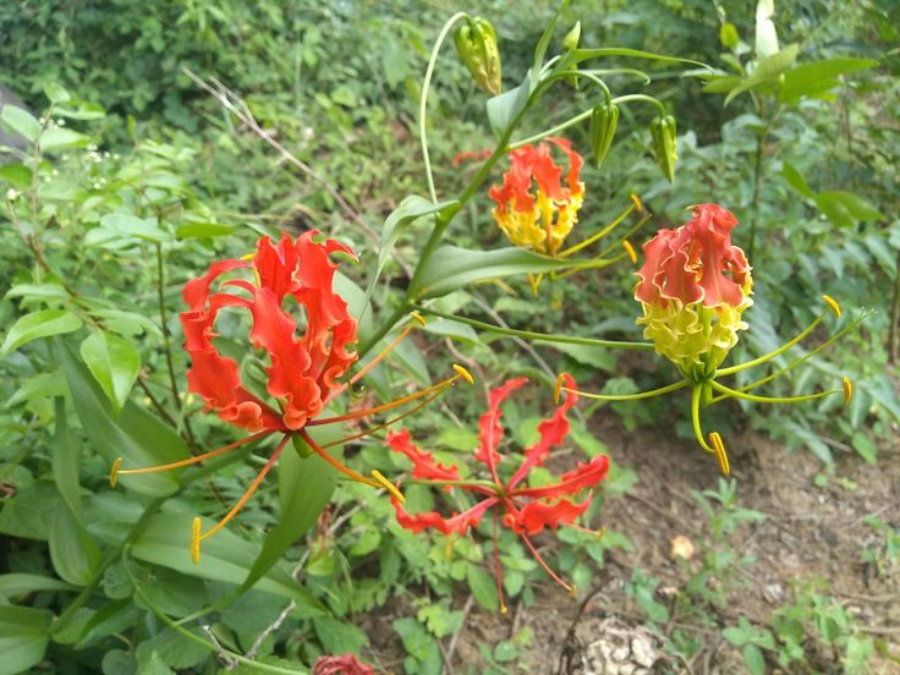Medicinal value of Senganthal flower
Senganthal flower (Gloriosa superba) is revered as the state flower of Tamil Nadu. Senganthal flower is mentioned in seven places in the Sangam literature Batu Patu and Euttuya. The word Kanthal is used in 64 places. government on the verge of extinction, Senganthal State flower of Tamilnadu has received worldwide acclaim for its rare medicinal properties that can cure cancer.
The red rose is found in abundance on high mountains, ridges, and slopes. The color of the flower has been described by poets as fire-like, blood-colored, and light-matched.
In those days, Vedus had a habit of burning red flowers. Other women are also happy to draw the red rose along with other flowers.
The stem of this flag is green weak. The tips of the leaves are elongated and curled like magnets, holding the neighboring trees, etc.10-20 ft Height grows.
Beetles are always circling the nectar-rich red flower. Other flowers bloom and fall. But even if the red flower withers, it does not fall off. In villages, it is also called Kanvali flower. The flower is said to be so-called because looking at it causes eye pain.
Life-saving magnificence
Senganthal flower has been found to have rare medicinal properties that can cure cancer. The seeds and tubers of the red plant contain high amounts of Chloroquine and Colchicine, which can prevent the spread of cancer.
It is said that cancer can be prevented from spreading through chemotherapy by taking medicines from it. European countries and foreign pharmaceutical companies, including the United States, buy the seeds of the red plant in large quantities.
K M Sharatha Devi is working as an Assistant Professor in the Department of Biochemistry, Bharathiar University, Coimbatore. Similarly, Gurusaravanan is working as an Assistant Professor in the Department of Botany, Bharathiar University, Coimbatore
Both of them have discovered cancer-curing silver nanoparticles from the tuber extract of Tamil Nadu’s state flower, the red rose plant. The central government has granted a patent for this discovery of silver nanoparticles.
Patent granted by Central government
In a statement issued by Bharatiyar University, it is reported that the patent for this invention was applied for in 2020, but on the 31st of last month, the central government granted the patent.
Silver NanoParticles
Speaking about this, Professors Saradadevi and Gurusaravanan said that the current cancer drugs destroy cancer-affected cells. Not only that, current anti-cancer drugs also destroy non-cancerous cells.
However the silver nanoparticles found in the extract of the tuber of the red plant help the white blood cells to easily detect and destroy cancer-affected cells. Thus these particles help to recover from cancer. And these silver nanoparticles protect non-cancerous cells from being destroyed. In the first phase, we have successfully injected these nanoparticles into mice. It will take a few years to bring these nanoparticles to human use.
The tuber of the red plant is used variously in Ayurvedic and Unani medicine. Fenugreek is used as a medicine for snake bites, scorpion bites, etc. People who have been bitten by snakes grind the roots of this plant along with the root of this plant and eat the size of half a gooseberry every morning and evening for three days, then the poison will come down. No salt is essential. If bitten by small snakes or beetles, the poison will come off if the leaves are ground and rubbed with tea leaves and bathed.
Its flower looks like a burning fire, so it is called Aginisalam. Its tuber is plow-shaped, so it is called plow and ilangili.
Because the tips of the leaves are curled, it is also known as Thalaikuruli. In traditional medicine, it is also called Vendhondi.
As the color of the flower varies, it is classified into two different types, Venkanthal and Senganthal. The tubers that divide and have nodes are called male and those without nodes are called female. Gloriosa is a genus. It consists of five or six young. It belongs to the plant family Colchicaceae.
It belongs to monocotyledonous plants. It is found in tropical Africa and Asia. They are naturally found in parts of Africa, Southeast Asia, and Malaysia. Blooming during the Kartika period, this flower is found in Sri Lanka, India, China, the Malacca Peninsula, and equatorial Africa. It spreads over hedgerows, paths, and forest edges in beautiful finger-like, flame-like displays.
All parts are rich in alkaloids called colchicine. So if you consume these, death is likely to happen. Its root is highly poisonous. If its leaves and stems fall on us, the skin will itch. It is also known as Karthikaipoo. A tuber-like herb called Kanvalikijangu is obtained from the kanthal flower plant.
This tuber is also known as Kalipai tuber, Vendhonri tuber, and Karthika tuber. Colchicine and superpine are the medicinal constituents of this root. Its various medicinal uses are used in Indian medicine in India. It is also used in Africa.
General Uses
For women suffering from placental abruption during childbirth, grind green beetroot and apply it on the navel, abdomen, palms, and soles of the feet. Immediately the placenta descends.
Due to the abundance of nectar in red flowers, beetles and bees are always hovering around. Generally, all flowers are deciduous.
Worldwide Market
In Dindigul, Erode district, Chithod, and Dariyur, farmers are growing Senganthalflower in large quantities. Foreign companies purchase the seed at Rs.850/kg.
Although its tuber also has medicinal properties, as this crop grows for up to five years, its seeds are bought in large quantities. Senganthaltuber is sold at a price of Rs 300 per kg. This crop thrives even when there is little water. Tamilnadu flower has gained worldwide popularity due to its anti-cancer properties.
References:
- https://www.vikatan.com/health/96537-medical-benefits-of-senkanthal-flower
- https://timesofindia.indiatimes.com/city/coimbatore/bu-team-bags-patent-for-nanoparticles-for-cancer-drugs/articleshow/102868175.cms?from=mdr
- https://www.news-medical.net/news/20230310/New-insights-into-how-spider-lily-compound-kills-cancer-cells-while-keeping-healthy-cells-intact.aspx
- https://www.thehindu.com/features/metroplus/society/hidden-glory/article6461947.ece
Image References:
2.https://images.app.goo.gl/UxFUXYA9eUkWawV26

